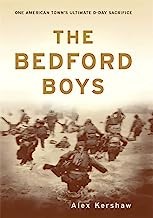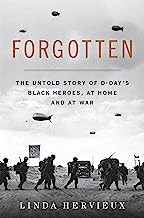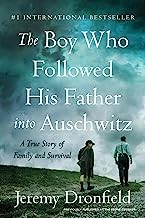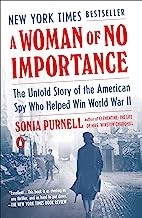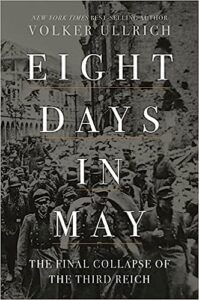NAZIS PLAN TO COLONIZE CENTRAL AND EASTERN EUROPE
Berlin, Germany • April 27, 1942
At least since the 1925 publication of Adolf Hitler’s political screed, Mein Kampf (My Struggle), National Socialists, or Nazis for short, were openly discussing various colonization schemes for Central and Eastern Europe. Nazis were sure that more Lebensraum (living space) for a population of 62 million people was needed if Germany were to assume a leading role among the community of world powers. The East must be cleared of what the German dictator termed culturally and racially inferior people (kulturell und rassisch minderwertige Voelker) and resettled with a “biologically” superior people of Aryan, or Nordic (that is, German) stock. As Fuehrer (leader), Hitler called on the terrible swift sword of his Wehrmacht (German military) and the allegedly more vigorous and intelligent German settler community, including Volksdeutsche (people whose language and culture had German origins but who did not hold German citizenship), to produce an ethnic transformation (Umvolkung) and a permanent German Volks- und Kulturboden (people’s and culture soil) in the East.
Between Nazi Germany’s invasion of its eastern neighbor Poland in September 1939 and the Wehrmacht’s sound defeat further east at Stalingrad in the Soviet Union at the end of January 1943, various abstracts and memoranda of Generalplan Ost (Master Plan for the East), each with different emphases, surfaced in the Reich Commissioner’s Office for the Strengthening of Germandom (Reichskommissariat fuer die Festigung deutschen Volkstums), widely known by the initials RKFDV, including a memo on this date, April 27, 1942. (The most senior officer in the RKFDV was Reichsfuehrer-SS Heinrich Himmler, head of the Nazi Party’s all-powerful paramilitary Schutzstaffel, or SS.) At least two more versions, one in late May (officially dated June and sent to Himmler for his imprimatur) and the other in late October 1942, tweaked the April plan. Though an intact copy has not been located to date, broadly speaking Generalplan Ost addressed agricultural, industrial, urban, and population resettlement of 4,550,000 people of German origin as well as transfer issues of 31 million “aliens” to be resettled (ausgesiedelt) to Western Siberia or else killed. (Of the Polish population 80–85 percent, or 20 million people, were to be resettled, the highest percentage for any conquered nationality.) Despite its costs and projected 30‑year run, the program to Germanize huge swathes of the East had its attractors, from Hitler and Himmler to the more than 750,000 Reich Germans and Volksdeutsche who eventually settled in Polish areas that had been either annexed by the Reich (West Prussia, Warthegau, and Upper Silesia) or occupied (General Government).
Ruthless, large-scale ethnic cleansing by SS-Einsatzgruppen (mobile death squads) and other SS police units made room for the rapid influx of German settlers across Poland. Roughly 800,000 non-Jewish Poles were expelled from their homes and farms and deported; 3 million Poles of Jewish descent were first crammed into urban ghettos and then evacuated to be murdered on an industrial scale in death camps with names like Auschwitz-Birkenau, Bełżec, Majdanek, Sobibór, Chełmno (Kulmhof), and Treblinka; and 1.7 million Fremdvoelkische (foreign people) were deported westward as forced laborers to Reich mines, factories, and farms. Between 20,000 and 50,000 Polish children who had Aryan-Nordic features (eye and hair color, shape of head and nose, height, skin color, etc.) and passed a medical exam and performed well on psychological tests were given false birth certificates attesting to their pure-blooded (reinrassig), German-born status. The children, many of them kidnapped by SS cadres from orphanages and schools and off city streets, were put up for adoption by “suitable” Reichsdeutsche families in the West. Abducting children (estimated between 200,000 and 400,000 children from all over Europe), expulsion of peoples from their natal communities, and genocide were part and parcel of Germanizing the Ostgebiete (Eastern Territories).
Germanizing and Colonizing the Ostgebiete: Generalplan Ost and the Example of Poland During World War II
 |
Above: Generalplan Ost, 1942, Nazi Germany’s secret master plan to reorganize the racial, ethnic, and cultural landscape of Central and Eastern Europe using genocide, ethnic cleansing, deportation, and enslavement on a vast and criminal scale. This map depicts pre-war German borders in gray-green shade. The area inside the red line defines pre-war Germany and adjacent territories that were annexed by the Hitler regime. (There were administrative, legal, and judicial differences between annexed, or incorporated, areas and occupied areas.) The white area between the wavy red line and the heavy broken black line (roughly Lake Ladoga-Volga-Don rivers) depicts the second phase of German settlement and included the establishment of the General Government and the Reichskommissariats Ostland (the Baltic States and Western Belarus) and Ukraine. To the south of those areas are territories and states that were allies of Nazi Germany (north to south: Finland, Slovakia, Romania, Bulgaria, Yugoslavia, and Italy). East of the broken black line are theoretical political divisions and planned civilian occupation regimes in northern and central European Russia, Moskowien (also spelled Moskau) and Kaukasien (also spelled Kaukasus) to the south that were never realized owing to the Wehrmacht’s westward retreat on the Eastern Front, which gathered momentum in 1943–1944. Yellow represents neutral states in World War II, which conflict in Europe ended in May 1945.
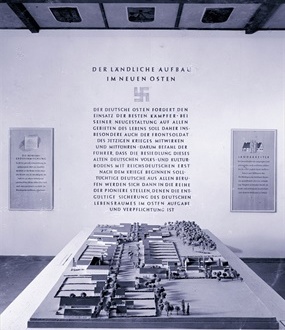
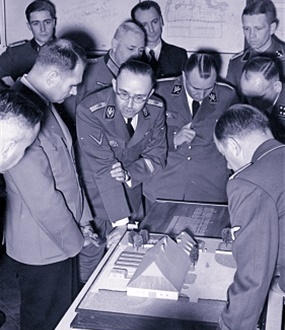
Left: A model of a proposed settler community in Germany’s “New East” (Neuer Osten), whose so-far “badly exploited, fertile soil of black earth could be a paradise, a California of Europe,” prophesized Hitler. In March 1941 the settlement planners under Reichsfuerher-SS Heinrich Himmler organized a public exhibition in the German capital, Berlin. Under the title “Planning and Construction in the East,” the exhibition used display boards and models on tables that depicted what future villages in the “newly won eastern territories” should look like. The exhibition was repeated in October of the same year.
![]()
Right: Using miniature model homes, villages, and farms laid out on display tables, Himmler explained his settlement plans to Rudolf Hess (folded hands left), Deputy Fuehrer of the Nazi Party, on March 20, 1941. Inside the exterior walls of the miniature homes were representations of living rooms, kitchens, bathrooms, and bedrooms. Hess appeared on Hitler’s behalf at Nazi rallies and engagements like this one. Hess was next in line to Reichsmarshall and Luftwaffe chief Hermann Goering to succeed Hitler until the Deputy Fuehrer’s fateful solo flight to Scotland on May 10, 1941, when he hoped to initiate peace talks between Germany and Great Britain. Embarrassed by Hess’s stunt, Hitler abolished the post of Deputy Fuehrer, stripped Hess of his party and state offices, and secretly ordered him shot on sight if he ever returned home.
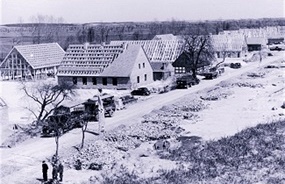 | 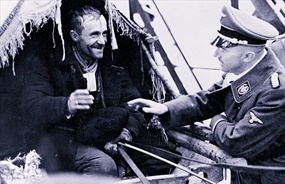 |
Left: Planners around agronomist SS-Oberfuehrer (Brigadier General) Dr. Konrad Meyer-Hetling publicly promoted their visions for new settlements in the conquered, resource-rich Ostgebiete. It was Meyer-Hetling’s mid-1940 memorandum as chief of the RKFDV Planning and Soil (Planung und Boden) Department to Reichsfuehrer-SS Heinrich Himmler on the “Germanization” of the Eastern Territories that morphed into Generalplan Ost. In order to make the conquered areas permanently German, Meyer-Hetling and his acolytes planned to settle over 4.5 million Germans along with “Germans” from Western Europe (e.g., Alsace-Lorraine and Luxembourg) and America in the Warthegau, an area of Poland incorporated into the Third Reich. Other settlement areas included the General Government (home to 10 million Poles), Byelorussia (today’s Belarus), and Ukraine, the latter two states being western parts of the Soviet Union. This was all to happen inside 20 years, down originally from 25–30 years. Chairing the Committee for Resettlement in the Occupied Eastern Territories, Meyer-Hetling opined that the settlers would “biologically” displace what remained of the indigenous population. The photo on the left shows the new construction of a model resettlement village in the Warthegau. In the wake of the calamity that befell the Axis armies at Stalingrad and Germany’s declaration of Totaler Krieg (February 18, 1943), Hitler suspended further planning for colonizing the “Germanic East” with “Germanic blood” until peacetime, and so the resettlement program was gradually abandoned.
![]()
Right: In this photo Reichsfuehrer-SS Himmler, in his role as resettlement commissioner (RKFDV), welcomes a smiling Volksdeutscher resettler from Galicia to Przemysl (German, Premslau or Prömsel) district. Przemysl lay in that part of German-occupied Poland known as the General Government (German, Generalgouvernement). In July 1941 Galicia was separated from the General Government to form its own administrative district, Distrikt Galizien. The district ceased to exist after the Soviet counteroffensive in 1944. Galicia is now part of Western Ukraine.
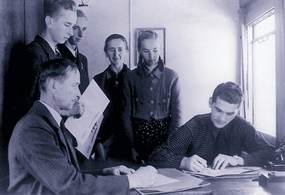 |  |
Above: In the plans for colonizing Central and Eastern Europe, Volksdeutsche played a key role—but only if and when they were certified to be “racially desirable” (rassische erwuenscht) and without any disturbing political blemishes (politisch unbedenklich). Himmler’s SS registered all incoming immigrant settlers in a rigorous procedure. The procedure involved a central registration database called the German People’s List (Deutsche Volksliste, DVL) that racially ranked males and females in the conquered East according to their degree of “Germanness.” For example, DVL categories I and II distinguished would-be colonists based on their “active” or “passive” engagement with the Reich before 1939: Volksdeutsche (active) vs. Deutschstaemmige (German descendants, passive), and rewarded membership differently. Members of categories III and IV were sent to Germany as laborers and subject to conscription into the Wehrmacht. Persons who had been assigned to one of the four DVL categories but who denied their ties to Germany were dealt with very harshly and ordered to concentration camps. Thus, Gliebe family applicants from Slovenia (a state in former Yugoslavia), shown here in both frames, had to pass civil, racial, and health tests if they were to receive their naturalization papers (Einbuergerungsurkunden). The two photos were taken in 1941 for documentation and propaganda purposes.
Germany’s Generalplan Ost and the Genocide Years: 1939–1945
![]()

 World War II was the single most devastating and horrific event in the history of the world, causing the death of some 70 million people, reshaping the political map of the twentieth century and ushering in a new era of world history. Every day The Daily Chronicles brings you a new story from the annals of World War II with a vision to preserve the memory of those who suffered in the greatest military conflict the world has ever seen.
World War II was the single most devastating and horrific event in the history of the world, causing the death of some 70 million people, reshaping the political map of the twentieth century and ushering in a new era of world history. Every day The Daily Chronicles brings you a new story from the annals of World War II with a vision to preserve the memory of those who suffered in the greatest military conflict the world has ever seen.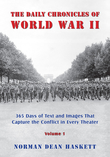 History buffs, there is good news! The Daily Chronicles of World War II is now available as an ebook for $4.99 on Amazon.com. Containing a year’s worth of dated entries from this website, the ebook brings the story of this tumultuous era to life in a compelling, authoritative, and succinct manner. Featuring inventive navigation aids, the ebook enables readers to instantly move forward or backward by month and date to different dated entries. Simple and elegant! Click
History buffs, there is good news! The Daily Chronicles of World War II is now available as an ebook for $4.99 on Amazon.com. Containing a year’s worth of dated entries from this website, the ebook brings the story of this tumultuous era to life in a compelling, authoritative, and succinct manner. Featuring inventive navigation aids, the ebook enables readers to instantly move forward or backward by month and date to different dated entries. Simple and elegant! Click 